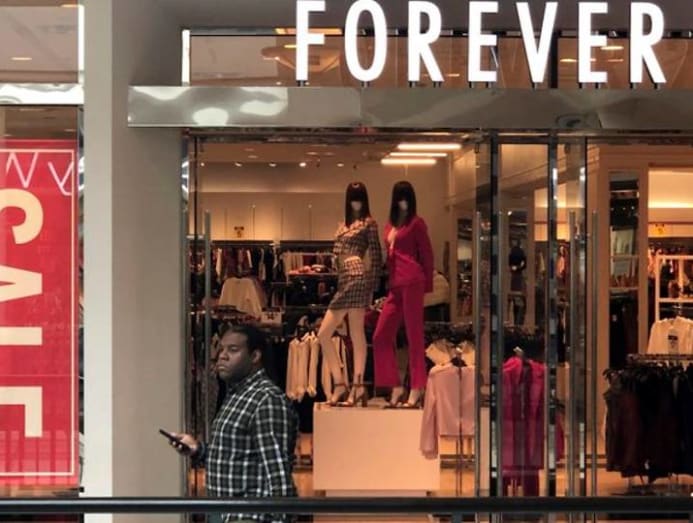Commentary: Chinese fashion giant Shein has taken over the world. It has just met its match
Shein is outshining its fast fashion competitors when their market outlook is dim – but a growing countertrend of eco-consciousness might be its downfall, say researchers.

YouTube thumbanil of a Shein haul video. (Screengrab: YouTube/Laura Lee)
LAUSANNE, Switzerland: If you’re a regular on TikTok, you might be familiar with the cult of Shein, the online fashion retailer.
Under the hashtags #shein and #sheinhaul, users post short clips of themselves flaunting their latest Shein purchases, from skin-tight tank tops and plaid skirts to chunky belts and delicate necklaces.
Some of these users spend hundreds of dollars per haul.
Shein emerged in 2008 out of China’s ancient capital Nanjing. It has since become the world’s largest, purely online fashion company in terms of sales of self-branded products, according to Euromonitor.
Shein’s competitive advantage lies in leveraging hype generated online by Gen Z users over the hottest new fashions, then delivering those pieces on its platform faster than its rivals. Where Zara and others take weeks to ready new collections, Shein presents hundreds of new designs on a weekly basis at about 50 per cent of Zara’s prices for comparable products.
READ: China's turbo-charged online fashion takes on Zara and H&M
SHEIN OUTSHINES ITS RIVALS
Having no physical stores, Shein experienced a COVID-19 boon. In September 2020, Shein’s app saw 10.3 million downloads globally, in contrast to the H&M app’s 2.5 million downloads, and Zara’s 2 million. By April, Shein became the most downloaded shopping app in the US.
Today, Shein is estimated to be worth US$30 billion, and is backed by global investors like IDG Capital and Sequoia. While the company said it has no plans for an initial public offering, an insider said it has employed Goldman Sachs to advise on a potential IPO.
Shein is outshining its fast fashion competitors when their market outlook is dim. Hit by lockdowns, UK retailer Primark lost £1.1 billion (US$1.5 billion) from store closures. It’s a brick-and-mortar chain that has refused to go online.
Meanwhile, Forever 21 went bankrupt even before COVID-19 hit.
READ: Commentary: Life after COVID-19 — fashion's excesses curbed, shopping habits forever changed

The overall long-term future of fast fashion companies does not point upwards. While Fast Retailing, which owns Uniqlo, almost doubled its value since 2017, Inditex, owner of Zara, only increased its share price by about 14 per cent, while H&M has shed 17 per cent.
But Shein’s competitors aren’t quite these fast fashion stalwarts, or other e-commerce platforms like Amazon. Its greatest competitor is inattention. Whenever customers shopping for clothes find something that diverts their attention away from Shein’s stream of new product launches, Shein’s sales are in danger.
Maybe this makes Shein an entertainment fashion brand that happens to make money with instant fashion. Where habits and convenience drive users to the big e-commerce giants, surprise and desire attract them to Shein.
READ: Commentary: The COVID-19 crisis has put luxury brands in a fix
Shein is also positioning itself as a community for fashion enthusiasts by encouraging customers to share their buys on social media. As of July, over 900,000 posts on Instagram featured the tag #sheingals. By building a consumer-centric brand, Shein is seen as much more than just an online store for cheap clothing.
And Shein is also different from other Chinese clothing manufacturers with online stores on Shopee or Alibaba, namely because Shein’s main markets are overseas. Its biggest market is the US.
Going forward, Shein, the brand coveted overseas, will find a debut at home easy. This will add the heft of unprecedented scale to its operations and pricing power.
READ: Commentary: After the coup, Myanmar’s garment industry hangs by a thread
TRADITIONAL FAST FASHION STARTING TO LOOK SLOW
Competitive pressures also darken the outlook for many fast fashion players. Their business model is based on high-speed replication of new trends.
Traditional players like Zara and Uniqlo leverage their network of local stores to quickly grasp the sales trends in different locations through their point-of-sales systems and analysis of offline and online shopping habits. They had established a fashion cycle where new items are dropped every six to eight weeks.
But new players have beat them at their own game of speed. Shein releases over 5,000 new items every day.

Online retailers have direct access to customers. The high quantity and quality of data on what individual customer purchase in combination with their history provides invaluable insights on which items will catch on or not.
Shein grafts information from websites and integrates profiles of customers with predictions about what materials, styles and colours partners should use.
Such access to data and the ability to fine-tune products strongly incentivises Shein and other online retailers to avoid a business-to-business model. Shein’s £300 million bid for Topshop in the UK in January indicates that it is aiming for the business-to-customer top spot (ASOS eventually bought Topshop and its affiliates for £330 million).
In the past, dealing through retailers would have been the only way for fashion brands to be present worldwide. Today the situation is flipped.
Online interactions with customers, one-on-one, can be less complex, even on a global scale, than having local retail representations or distributors that would add regulatory headaches of taxation, disclosure, compliance and possibly consignment sales. A third man in the value chain would only slow down Shein.
READ: Commentary: In the time of COVID-19, China is revolutionising deliveries and e-commerce
READ: Commentary: How to sell clothes during a retail apocalypse
GROWING CONCERNS OVER FASHION’S ENVIRONMENTAL IMPACT
With fast fashion firms under pressure to stay ahead of fashion cycles and entertain customer desire for the newest styles, there’s a growing countertrend that questions its breakneck speed.
The global fashion industry generates about 4 to 10 per cent of total greenhouse gas emissions, more than all international flights and maritime shipping combined.
According to the World Bank, the fashion industry uses 93 billion cubic metres of water every year, an amount that 5 million people could use for consumption instead.
The industry also produces about 20 per cent of wastewater worldwide through dyeing and treating fabrics. It dumps microfibers that amount to about 50 billion plastic bottles into the ocean and disposes 87 per cent of total fibre input annually.
These negative effects of fashion are predicted to increase by 50 per cent by 2030, as more buy into the ethos of fast fashion: Buy fast, buy new, and dispose prematurely. According to the Ellen MacArthur Foundation, the average person today buys and discards about 60 per cent more clothing compared to 2000.

Fast fashion leaders have launched initiatives that boost their sustainability record, though they’ve been met with scepticism. Although H&M has started already in 2010 with its Conscious Collection emphasising organic and sustainable fabrics, the Norwegian Consumer Authority said information provided about the clothing, such as the amount of recycled material in each item, is insufficient.
A rejection of overconsumption in favour of essentials and basics, espoused by brands like Patagonia, fares better with those concerned about fashion’s environmental impact.
New models are emerging fast. Business models of vintage, recycled clothes are quickly losing their stigma in the West.
READ: Commentary: S$5 tank tops can end up costing too much
THE RISE OF AN ALTERNATIVE FASHION INDUSTRY
The fashion industry is now at a crossroads, and the path it takes will determine if behemoths like Shein wind up as winners or losers.
Will companies manage to adapt to a fashion world that embraces sustainability while developing new choices for consumers?
In China, the pre-loved clothes business is booming, and not just of the cool vintage, or high-end boutique type. Boring old clothes are becoming a business. Companies such as Yi Jia Yi Clothing, founded in 2006, focus on trading bulk used clothing.
READ: Commentary: Secondhand clothing sales are booming – and could be the answer to fashion’s sustainability crisis
This fits a larger trend of recycling in the East attracting investor attention. The upcoming IPO of JD.com backed Aihuishou, which hawks used electronics, and the rise of trillion-yuan Alibaba resale market Xianyu, show confidence in China`s second-hand goods platforms.
As with more sectors and technologies, Asian innovators may provide creative answers to the world’s pressing problems.
IMD Professors Patrick Reinmoeller and Mark Greeven run IMD`s Asian Innovation Strategies program. Yunfei Feng is lead researcher on Asian innovation and co-author of Mark`s book on The Future of Global Retail.








